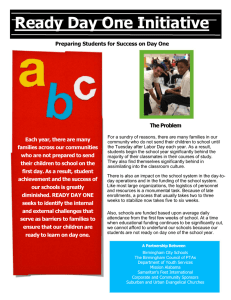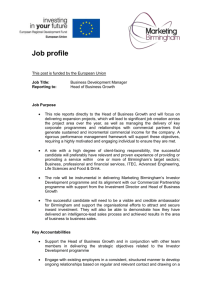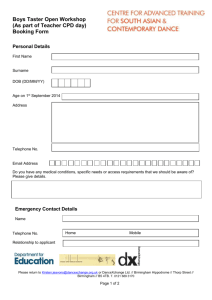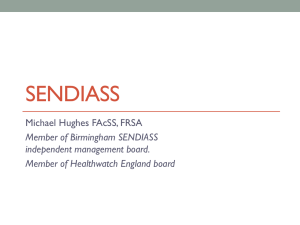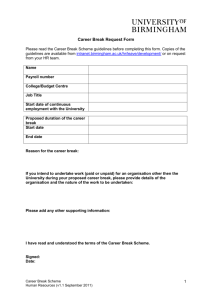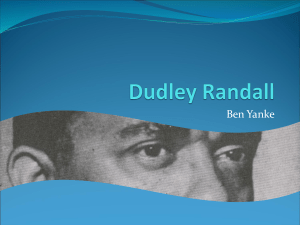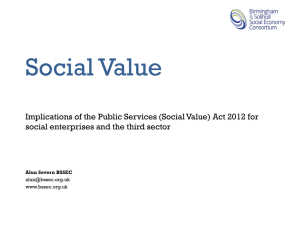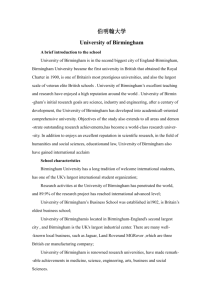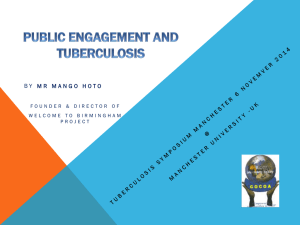Public Art Strategy 2015 - Birmingham City Council Consultation Hub
advertisement
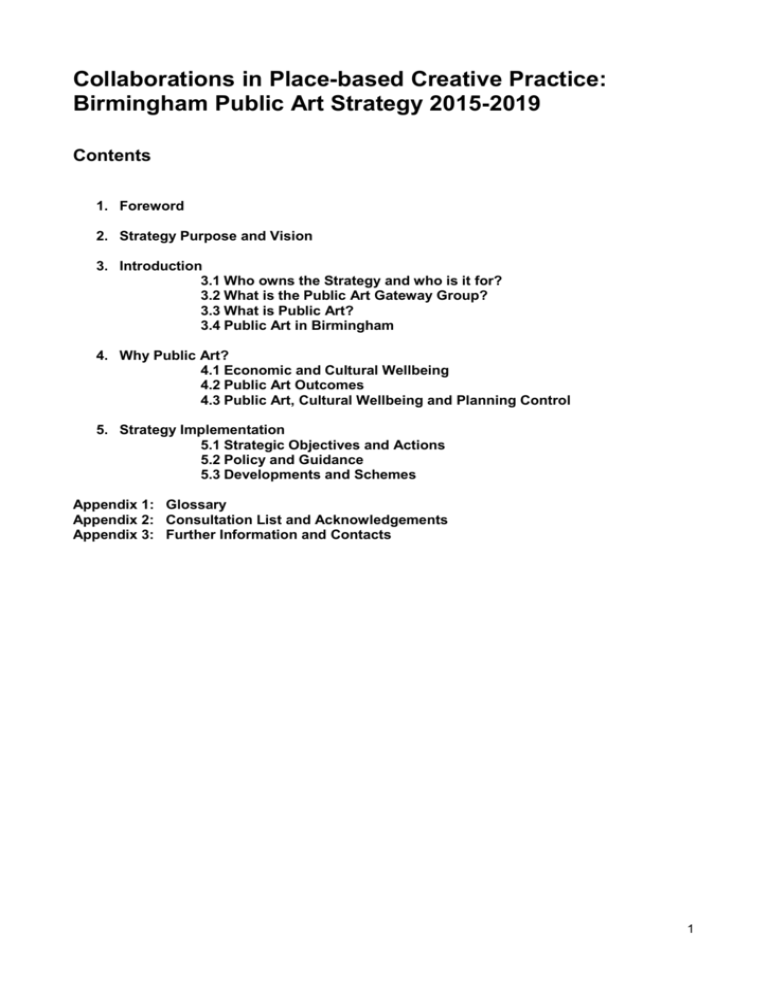
Collaborations in Place-based Creative Practice: Birmingham Public Art Strategy 2015-2019 Contents 1. Foreword 2. Strategy Purpose and Vision 3. Introduction 3.1 Who owns the Strategy and who is it for? 3.2 What is the Public Art Gateway Group? 3.3 What is Public Art? 3.4 Public Art in Birmingham 4. Why Public Art? 4.1 Economic and Cultural Wellbeing 4.2 Public Art Outcomes 4.3 Public Art, Cultural Wellbeing and Planning Control 5. Strategy Implementation 5.1 Strategic Objectives and Actions 5.2 Policy and Guidance 5.3 Developments and Schemes Appendix 1: Glossary Appendix 2: Consultation List and Acknowledgements Appendix 3: Further Information and Contacts 1 1. Foreword Public art is an important and necessary ingredient in the life of a modern city. Art has the power to provoke, inspire and transform. It plays a strong role in shaping place, enhancing the environment and supporting the reputation of a town or city. Art forms a focus for storytelling, navigation and community engagement, it connects places and people. Art can stimulate the local economy, provide opportunities for artists and creative people, and contribute to our shared sense of identity. The purpose of this Strategy is to refocus our relationship with public art, and advocate the value of having a good quality portfolio and programme of both permanent and temporary (including eventbased) public art. Here in Birmingham we have a diverse range of public art, everything from statues of scientists of the enlightenment; the pioneers of emancipation, and civic leaders who fought for the vote during the 19th century; through to late modern artworks such as Anthony Gormley’s Iron:Man (1993) in Victoria Square and Ondre Nowakowski’s Sleeping Giant (1992) near St Andrew’s Stadium, which often has its nose painted blue by Birmingham City Football Club supporters. Alongside these, Birmingham hosts an array of festivals that reanimate our city, allowing us to rediscover the familiar through film, dance, theatre, music and visual arts. Our iconic art works range from John Bridgeman’s recently listed 1960s concrete Play Sculpture in Acocks Green to Laurence Broderick’s Bronze Bull marking the entrance to the Bull Ring Shopping Centre, a popular attraction with visitors queuing to have their photograph taken with the artwork. The more recent public artwork, Gillian Wearing’s A Real Birmingham Family (2014) challenges the concept of what makes a modern family, and we look forward with anticipation to the outcome of one of the latest initiatives, the Big Birmingham Art Project, planned for the centenary of Birmingham Civic Society in 2018. In many cases public art reflects, and is a source of, controversy, debate and difference of opinion. This, in our view is a good thing. Most public artworks are not intended to be ignored; they are intended to be useful and engaging to a place and to its communities. A Real Birmingham Family is a good example of this, creating something of a media furore and strong opinions both for and against. In considering the future for public art, there is no place for being timid or afraid of controversy. Instead, let’s allow our public art to challenge and contribute to these debates, and act as a catalyst for collective thinking about what we want from our society. Forming a part of Birmingham’s new Cultural Strategy, this Strategy reflects a wide range of considerations including quality, impact, local engagement, siting and maintenance. This Strategy establishes a framework for commissioning and funding future artworks, and how Birmingham will care for its public art in the context of budget cuts that mean that the Council cannot fulfil this task on its own. Looking forward, collaboration in place-based practice and sharing of resources between all of Birmingham’s stakeholders will be needed to ensure we have good quality public art, whether it is temporary, permanent, new or existing. Councillor Ian Ward Deputy Leader Birmingham City Council Councillor Penny Holbrook Cabinet Member for Skills, Learning & Culture Birmingham City Council 2 2. Strategy Purpose and Vision 2.1 Strategy Purpose The purpose of this Strategy is to: set out a clear vision for public art in Birmingham advocate the role of public art for Birmingham’s economy and communities where appropriate, ensure public art programmes are included in new developments, and in particular, major developments encourage partnership working with a range of private and public stakeholders to diversify and strengthen sustainable funding for public art in Birmingham ensure the management and maintenance of our public art is appropriate and of a high quality engage artists, residents and other partners with the developments in their city through public art programmes provide policies and guidance in regard to development and implementation of public art in Birmingham, ensuring public art enquiries and new schemes are taken through the Public Art Gateway Group 2.2 Strategy Vision We need an improved public art portfolio and public art programme across the city, in local neighbourhoods and within the city centre. It should be enjoyed by residents and visitors alike, and further add to Birmingham’s reputation as a top cultural destination, bringing people together to celebrate our heritage and be part of our future. This means ensuring our existing public art is well looked after, with improved conditions for adequately funded new art commissioning and collaborative place-based creative practice for temporary and permanent art. 2.2 Our vision is for our temporary and permanent public art to be: 2.3 This Strategy supports the development of public art projects and initiatives that can contribute to the following aims: 1 strengthen Birmingham’s communities and place-shaping 2 enable Birmingham residents (including young people) to experience creativity, and have the opportunity to develop as creators, participants, audiences and leaders in the cultural field 3 improve Birmingham’s reputation as a desirable location where people and businesses want to be 4 enhance Birmingham’s cultural offer for residents and visitors 5 enhance the quality of the public realm, including parks, streets and public open spaces 6 recognise and create key events, personalities and moments in Birmingham 2.4 This vision and aims will be achieved through six objectives, each with an action plan. These objectives focus on: 1 Commissioning Practices for Public Art To improve the practice of commissioning and developing public art in Birmingham 2 Funding New Public Art To improve the funding base for commissioning public art 3 3 Facilitating Changes to Birmingham’s Public Art Portfolio To improve the functioning and awareness of BCC’s internal Public Art Gateway Group 4 Supporting Artists and a Collaborative Public Art Ecology To improve the information, advice and support available to local artists engaged in public realm working 5 Maintaining Public Art To improve the management of the existing portfolio of public art in Birmingham 6 Promoting Public Art To improve awareness of and education about public art in Birmingham 4 3. Background 3.1 3.1.1 Who owns the Strategy and who is it for? The Strategy’s production has been overseen by the Public Art Strategy Steering Group, chaired by Councillor Holbrook (BCC Cabinet Member for Skills, Learning & Culture). Members include the BCC Deputy Leader, representatives from BCC Culture and Visitor Economy Services; BCC Planning and Regeneration Services; Birmingham Museums Trust, Birmingham City University, Glenn Howells Architects; Eastside Projects and advice and guidance from ixia public art think tank. 3.1.2 Public Art commissioning and maintenance responsibilities cross over a range of BCC services, and increasingly involve a wide range of public bodies and private sector developers. Therefore this Strategy has been written for, and where possible, includes contributions from: developers; Business Improvement Districts and local town centres; businesses; schools; the higher and further education sector; the health sector; community and resident groups; the housing sector; the environmental sector; the heritage and cultural sectors; planners; artists; architects; engineers; urban and landscape designers and the transport and infrastructure sector. 3.1.3 A Public Art Strategy Implementation Group will be brought together from a range of stakeholders in order to take forward the action plans outlined in Section 5. A number of actions will also be taken forward through the Public Art Gateway Group and other relevant existing committees, such as those taking forward the wider Cultural Strategy. The Strategy will be reviewed on an annual basis to ensure updated action plans and new policy developments are incorporated as appropriate. 3.2 3.2.1 What is the Public Art Gateway Group? The Public Art Gateway Group is a Council officer working group set up to facilitate changes to Birmingham’s public art portfolio, advise on new commissions and upcoming schemes, and make recommendations for decisions relating to public art. Group representation includes: BCC Highways, BCC City Centre Management, BCC City Centre Design and Conservation Team, BCC Culture Commissioning Service and Birmingham Museums Trust. 3.3 3.3.1 What is Public Art? Public art is a place-based creative practice: the act of producing permanent or temporary (including participatory and event-based) art within the public realm. The outcome of the artists’ creative practice can form a part of the infrastructure of the physical built environment, or it can form a part of the community engagement process of developing or redeveloping an area. It could be a permanent work, temporary space-specific work, or could form part of a festival, series of events or interventions. Examples of different approaches to public-realm art practices have been included in section 4.2. 3.3.2 The artists that create art within the public realm are frequently also residents of the city, aided often by other residents such as curators, designers, community organisations, resident groups, architects, engineers, planners and technicians. While they may be based in Birmingham, these artists often work nationally and internationally. Equally, teams of artists, curators and technicians from national and international cities will be commissioned to create art within Birmingham’s public realm. “Birmingham is a place with many differences and we need many different artworks to truly reflect who and what we are. Art can be made of anything, and so can cities. Each city or artwork may have its own characteristics, histories, quirks and accents.” “Public art can transfer power to people and invite active discussion rather than just passing observation. It can increase the vitality of public space and work with the surrounding environment; temporary time-sensitive projects can make the art even more precious.” 5 Gavin Wade, Director, Eastside Projects “Public art can be appreciated and enjoyed on many different levels, and can be designed for a specific moment in time with maximum powerful impact on people” Public Art Strategy Stakeholder Event attendee “Public art can respond directly to the unique history and culture of the city. It should convey cultural confidence.” Public Art Strategy Stakeholder Event attendee “Artists can help create creative, attractive memorable spaces that allow the city to breathe” Public Art Strategy Stakeholder Event attendee Public Art Strategy Stakeholder Event attendee “Public art can engage with universal themes, offer multiple readings and interpretations; act playfully and engagingly to a broad audience, and offer the possibility for critical engagement.” Public Art Strategy Stakeholder Event attendee “Public art can combine new and contemporary with the historic fabric, re-imagining the historic; creating a spectacle and a mystery yet in itself be beautifully simple.” Public Art Strategy Stakeholder Event attendee “Public art can celebrate diversity and celebrate our connections with other cities” Public Art Strategy Stakeholder Event attendee 3.4 Public Art in Birmingham 3.4.1 Birmingham’s current public art has grown from the city’s strong heritage of crafts and industry, developing through various national and local initiatives throughout the decades leading up to the millennium. The presence of the Public Art Commissioning Agency (PACA) in Birmingham through the late 1980s and 1990s, as well as a strong crossdepartmental interest and commitment to public art within the Council, saw Birmingham achieve nationally critically acclaimed schemes during this period: the International Convention Centre development and civic square redesign such as Centenary Square and Victoria Square. Of particular note was the belief in artists’ ability to work as part of design teams1. Housing renewal and regeneration schemes such as those in Nechells, Acocks Green and more recently, Castle Vale and Attwood Green, have included extensive programmes of public art commissioning, both temporary and permanent. 3.4.2 Several surveys of Birmingham’s public art exist; the most recent comprehensive review was completed in 2003, but only includes works within 3 miles of the city centre. There are currently over 300 artworks, statues, clocks, monuments, fountains, reliefs and mosaics logged by the Public Monuments and Sculptures Association (PMSA), based on G.T.Noszlopy’s2 research. Birmingham Museums Trust (BMT) regularly review the list of public art, clocks, fountains and monuments owned or looked after by Birmingham City Council. Section 5 of this Strategy identifies an action to update this survey of public art in Birmingham. 3.4.3 It is also important to remember the rich legacy of temporary projects and events which have affected the experience of residents of and visitors to the city. There has not been an exhaustive survey of these works and they are, by their nature, harder to trace but are an equally significant element of the history of public art. People in Birmingham have come into contact with art works through discussion with artists, artist-led events, and the presence of temporary works in their area or a spectacle in the city centre. Ikon off-site projects and Fierce festival works have taken place in all these forms, as well as sitespecific work at the biennial Birmingham International Dance Festival and innumerable other individual place-based commissions. Such projects have had a lasting effect on individuals’ and communities’ perception of and relationship with the city.3 1 L. Hards, Forward and Backward: Strategy and Evolving Public Art Practices in Birmingham, 1985-2010 (2013) G.T. Noszlopy, Public Sculpture of Birmingham including Sutton Coldfield (1998) 3 L. Hards, Forward and Backward: Strategy and Evolving Public Art Practices in Birmingham, 1985-2010 (2013) 2 6 4. Why Public Art? 4.1 4.1.1 Economic and Cultural Wellbeing The Strategy celebrates public art for its intrinsic arts value, as well as its links to other Council policies where culture-led innovation can make a huge difference to non-arts agendas: “Participation in culture is inherently a good thing - it challenges perceptions, prompts feelings of happiness, sadness, anger and excitement, creates moments of personal reflection and enables people to understand the world they live in, its possibilities and the cultures of others more profoundly. Cultural activities can also deliver a range of other outcomes including health and wellbeing, social and community cohesion, civic engagement, economic impact, development of transferable skills and improved environment.” - Big City Culture: Birmingham’s 2010-15 Cultural Strategy (2010) 4.1.2 By maximising engagement and funding opportunities, as well as improving the conditions for new art commissioning and collaborative place-based creative practice, we can better care for our public art heritage, and generate new, exciting and unique, good-quality public art across Birmingham. We want to allow public art’s transformative nature to reach its full potential, challenging perceptions and enabling people to better understand the world they live in along the way. Both this Strategy and the refreshed Birmingham Cultural Strategy will recognise the support needed to grow and sustain the local cultural ecosystem of the city. 4.1.3 ACE’s refreshed Strategy Great Art and Culture for Everyone4 (2013) re-focused the agenda to creating the right conditions to help arts, museums and libraries to thrive and to be excellent; to stimulate as many people as possible through arts and culture and for children and young people to experience arts and culture more. These are all core values in line with Birmingham’s Cultural Strategy that should be reflected in new commissioning of public art. 4.1.4 ACE looked at the value of arts and culture to people and society through a comprehensive review5 (2014). The report concluded that arts and culture boost the economy through attracting visitors, creating jobs and developing skills, attracting and retaining business, revitalising places and developing talent. The report also recognized the positive impact arts and culture can have on health and wellbeing, and wider social benefits: those involved with arts tend to be more active as volunteers and contribute more to social capital and community cohesion. When arts and culture are included within education it can improve literacy, language and maths skills. 4.1.5 As such, the commissioning and development of public art schemes could significantly contribute to the outcomes of the following Birmingham policies, strategies and white papers: Birmingham Council Plan Birmingham Development Plan 2031 Big City Plan and associated Area Masterplans, including Birmingham Curzon HS2 Masterplan and the Snow Hill Masterplan Area Plans and Neighbourhood Plans, including Selly Oak Supplementary Planning Document and Balsall Heath Neighbourhood Plan City Centre Public Realm Strategy Supplementary Planning Document Other relevant Supplementary Planning Documents, including Lighting Places and the Parks and Open Spaces Strategy 4 Arts Council England (2013) Great Art and Culture For Everyone: 10-Year Strategic Framework 2010-2020 (2nd Edition, Revised 2013) 5 Arts Council England (2014) The Value of Arts and Culture to People and Society: An Evidence Review 7 Birmingham Cultural Strategy Birmingham Festivals Strategy Birmingham Heritage Strategy Greater Birmingham and Solihull Local Enterprise Partnership: Delivering Growth Strategic Framework Making Birmingham an Inclusive City: Community Cohesion White Paper Transforming Place (Neighbourhood Strategy) Birmingham Housing Strategy Birmingham Health and Wellbeing Strategy Birmingham Mobility Action Plan 4.2 4.2.1 Public Art Outcomes Public Art could contribute to the above strategies through the following six aims, as outlined in the Strategy vision: V1: 4.2.2 Helping to strengthen Birmingham’s communities and place-shaping Public Art can bring people from all sorts of different backgrounds together, whether this is contributing to its creation, or responding to it as an audience. Art works and art projects such as Leap of Faith by Mohammed Ali, Longbridge Public Art Project by WERK or temporary artwork Love Stirchley by Place Prospectors can enable residents and artists to work collaboratively and reflect on an area’s history, identity; its people and their connections. 4.2.3 Public art can empower residents and artists to have a voice, and actively shape the future of a place. Projects that successfully engage communities can create good quality and relevant public art, where residents can feel proud and have ownership. Such art works can contribute to place-making, feeling safe, cohesion and sustainable communities. There may be many future opportunities through housing, retail, industrial, office, or any other construction and development schemes, where artists and residents can be brought in early on to discuss how public art could enhance place making, safety and identity. V2: Enabling Birmingham residents (including young people) to experience creativity, and have the opportunity to develop as creators, participants, audiences and leaders in the cultural field. By its very nature, public art is open to all: it is, in the most part, free of cost to the spectator or participant, and generally in a public space. We need to ensure our public art is as inclusive and accessible as possible, and that the right resources and partnerships are in place with a range of sectors, including schools and community groups, to support artists and creative people to develop the public art sector and become influential advocates and leaders, so that everyone has the chance to see Birmingham in a new way through public art programmes. 4.2.4 “It is important to enable everyone to be creative “Engagement is a two way process” – to be given the confidence to think creatively, Public Art Strategy Stakeholder Event attendee to celebrate the creative world, to have the chance to see things another way” Public Art Strategy Stakeholder Event attendee V3: 4.2.5 Improving Birmingham’s reputation as a desirable location where people and businesses want to be. What lessons can we learn from Guinguette by Mark Pimlot (at the Mailbox underpass) and The Green Man by Tawney Gray (at the Custard Factory) in how public art can unlock and rejuvenate underused spaces and buildings, and reanimate them? We need our public art and creative spaces to keep on growing, so residents and businesses can continue to think of Birmingham as a great place to live, work and study; and for news of our distinct and creative places to continue to spread to other towns and cities regionally, nationally and 8 internationally, helping sustain our economy and attract new business investment. There are many upcoming development schemes where public art could be integrated, and there is potential to improve way-finding for traveling across the city, and celebrate Birmingham’s unique areas. V4: 4.2.6 Enhancing Birmingham’s cultural offer for residents and visitors To have bold, bombastic, stimulating, inspiring, provoking, innovating and challenging art, we need bold, inspiring, innovative artists, planners, developers and urban designers at the cutting edge of technology. We need artists to be at the table as often and as early in development discussions as possible (as in the case of Longbridge Public Art Project). We need a long lead in time to refine ideas and engage with residents and create the most interesting art works. We need to support our artist ecology and create opportunities for everyone to experience creativity, encourage creative thinking and share learning. V5: Enhancing the quality of the public realm, including parks, streets and public open spaces Public Art can contribute to the creation and upkeep of attractive, safe and enjoyable spaces and high quality streets. Public Art can also improve the legibility of the city by creating landmarks for pedestrians and cyclists; and create public realm that is distinctly Birmingham, take for example Boundary by Robert Colbourne and Stuart Mugridge at Birmingham’s National Express Coach Station public art project. 4.2.7 “Artists should be at the table as often and as early as possible for discussions about developments” Public Art Strategy Stakeholder Event attendee V6: 4.2.8 “Public art can help unlock and rejuvenate underused spaces and buildings” Public Art Strategy Stakeholder Event attendee Recognising and creating key events, personalities and moments in Birmingham. Birmingham has fantastic examples of art works celebrating key personalities and moments in the history of Birmingham, from James Watt to Kathleen Dayas. More can be done to engage residents and schools to interpret and re-interpret these artworks and their meaning in today’s context. It is also important to remember that public art can create an event, personality and moment of its own: Iron:Man in the past has been wrapped with a scarf, and temporary installations can create a real stir, such as Bennett Miller’s Dachshund U.N., featured at Fierce Festival in 2012. 9 4.3 4.3.1 Public Art, Cultural Wellbeing and Planning Control The National Planning Policy Framework (NPPF) recognises that cultural wellbeing is part of achieving sustainable development and includes cultural wellbeing within the twelve core planning principles, which underpin both plan-making and decision-taking. The NPPF states that the planning system should: ‘take account of and support local strategies to improve…cultural wellbeing for all…’6 4.3.2 The Planning Policy Guidance (PPG) complements the NPPF and provides advice on how to deliver its policies. The PPG states that: ‘Public art and sculpture can play an important role in making interesting and exciting places that people enjoy using.’7 4.3.3 Advice on the provision of public art via the planning system provided by the planning barrister, Ian Dove QC, to ixia public art think tank, states that: ‘Public art is an obviously legitimate expectation of development in circumstances where there is an evidence base in the form of design requirements or established public art policies and programmes which demonstrate the link between proposed development and public art…’8 4.3.4 The Farrell Review (2014) was an independent review into how the UK could ‘plan and design our future built environment’. The Review concludes: “The greatest failure of focusing on development control is the quality of the public realm, and we must strengthen the critical contribution of landscape, urban design and public art in making great places.”9 4.3.5 Many contributors to the Farrell Review stressed the role of the arts and artists in improving our everyday places: Contributing design and placemaking skills to architecture and the public realm Animating public space and creating a sense of place through permanent and temporary art, performance and street arts Engaging people of all ages and backgrounds in debating, conceiving, planning, designing and vitalising the public realm 4.3.6 Amongst its many recommendations relevant to public art were: Teach the built environment across all subjects in schools Decision makers should receive training in design literacy (e.g. planning committee members and highway engineers) ACE and Crafts Council could research and reinforce the role of artist and the arts in contributing to the planning, design and animation of public realm and architecture Local planning authorities should follow examples of best practice, where wider contextual plans and appropriate funding for landscape and public art are required from developers 4.3.7 The Town and Country Planning Association publication Improving Culture, Arts and Sporting Opportunities through Planning: A Good Practice Guide (2013) presents full justification for the use of arts and culture in planning, mapped against the NPPF. Useful guidance and toolkits show how public art can be integrated into good public realm and town planning schemes. 4.3.8 The Department for Culture, Media and Sport and Department for Communities and Local Government publication World Class Places (2009) drew attention to the importance of place-making. It identified a range of factors that contribute to quality of place and engender a sense of place and belonging – including well designed buildings, the public realm and 6 National Planning Policy Framework (Department of Communities and Local Government, 2012), paragraph 17. See: http://planningguidance.planningportal.gov.uk/blog/policy/achieving-sustainable-development/ 7 http://planningguidance.planningportal.gov.uk/blog/guidance/design/what-is-a-well-designed-place/#paragraph_018 8 I Dove QC, Re: ixia: Public Art and the Planning System Further Advice 2nd April 2014 (No5 Chambers, 2014), paragraph 9, page 5. See: http://ixia-info.com/files/2009/05/Public-Art-and-the-Planning-System-Ian-Dove-QC-Further-Advice-ixia-public-art-think-tank-2ndApril-2014.pdf 9 T Farrell et al, The Farrell Review of Architecture and the Built Environment, 2014, http://www.farrellreview.co.uk/ 10 green spaces, imaginative use of public art, sensitive treatment of historic buildings and sites, and provision of and access to a good mix of services and amenities in town and rural centres10. 4.3.9 Public art commissioning can contribute to the implementation of the Birmingham Development Plan 2031. The vision for Birmingham is: ‘…to ensure Birmingham’s residents will be experiencing a high quality of life, Iiving within attractive and well-designed sustainable neighbourhoods’. All new development will be expected to be designed to the highest possible standards, contributing to a strong sense of place. Public art can enhance the scope of a space and encourage flexible uses, as well as improve the environment and public realm. 4.3.10 Public art can contribute to the six design principles for creating a liveable, connected and authentic centre, with a high quality, attractive and pedestrian-friendly public realm and convenient, walkable connections within Birmingham’s city centre, as outlined in the City Centre Public Realm Strategy. These six principles are: distinctively Birmingham; attractive, safe and enjoyable places; high quality streets and spaces; pedestrians first; connected and legible; and a green and sustainable city. Public Art can also contribute to the delivery of other Supplementary Planning Documents (SPDs), such as the Lighting Places SPD. 4.3.11 Birmingham City Council encourages the commissioning of new works and programmes of public art via developers, as part of their overall onsite provision, using Section 106 agreements. Birmingham City Council also encourages contributions towards public art provision using Community Infrastructure Levy (CIL) funds. Public art could be commissioned under the following initiatives and statements included on the CIL Regulation 123 List: The Birmingham Big Art Project Birmingham Production Space Public Art Improvements which are not required as a direct result of a development Public Realm improvements which are not required as a direct result of a development 4.3.12 The use of planning contributions (Section 106 and CIL) for commissioning new public art programmes and works is subject to funds being available, as well as the BCC governance processes and approvals. Section 5 of this Strategy identifies actions for BCC to review these processes, promote opportunities for the inclusion of quality public art through the planning system, and ensure developers and other relevant bodies are given clear guidance on requirements for the inclusion of public art within their project, both through the wording and stipulations within the planning obligation as well as guidance with commissioning relevant and impactful art. 10Town and Country Planning Association’s Improving Culture, Arts and Sporting Opportunities through Planning: A Good Practice Guide (2013) p.8 http://cultureandsportplanningtoolkit.org.uk/fileadmin/user_upload/2013_Guide/TCPA_Culture_Guide.pdf 11 5. Strategy Implementation 5.1 5.1.1 Strategic Objectives and Actions The following six objectives underpin the Strategy’s vision. Each objective has an action plan. Collaboration with a wide range of partners will be required to take the Strategy forward. This will be overseen by a newly devised Public Art Strategy Implementation Group, with some specific actions to be undertaken by the Public Art Gateway Group as well as sub-groups of the wider Birmingham Cultural Strategy. 5.1.2 Further work will be undertaken by this Implementation Group to develop each action and review the resources and wider partnerships that may be required. The Group will also oversee the process of amending any of the below action plans in response to new initiatives, partnerships or other changes to the social, economic or cultural climate. The Strategy will be reviewed on an annual basis to ensure updated action plans and new policy developments are incorporated as appropriate. Objective 1: Commissioning Practices for Public Art To improve the practice of commissioning and developing public art in Birmingham While the Public Art Gateway Group currently provides advice to organisations about public art commissions (e.g. budgets, decision panels, materials, maintenance costs, risk assessments, artistic quality), more could be done to improve the practice of commissioning by widening the geographic spread and quality of submissions, improving the competitiveness of the process, and broadening the diversity of artists applying for opportunities. The actions identified look to improving these processes and the quality of Birmingham’s public art portfolio across the city in the longer term, as well as encouraging commissioning processes that allow for collaborative practices between the commissioning agent and the wider developer, architect, structural engineer, landscape designer and artist team, resulting in more innovative public art. O1 1 2 3 4 5 Actions Develop a Commissioning New Public Art policy and guidance/toolkit for developers, public art commissioners and planners (including considerations for ensuring artworks and programmes are fully accessible). Identify housing associations and officers to facilitate creative community engagement and placemaking projects. Increase children, young people and family involvement in commissioning art and in new public art schemes. Fill gaps in public art training and continued professional development opportunities for planners and other relevant professions. Improve the evaluation of public art (both social and economic impact). Lead & Partners BCC Culture Commissioning & BCC City Centre Design Timescale short term 201516 BCC Housing, arts organisations, housing associations PAGG, Arts organisations medium term 2015 - 2019 MADE, ixia, BCC, BCU, BAA, Developers, arts organisations ixia, BCC, ACE, universities, arts and heritage sector, residents medium term 2015-19 medium term 2015-19 longer term 2020 and beyond 12 Objective 2: Funding New Public Art To improve the funding base for commissioning public art Both the Birmingham Development Plan and Big City Plan identify several key development sites across the city over the next 15 years. There is currently no consistent approach to the way in which public art could be included in new developments. The Public Art Gateway Group provides advice and guidance on public art commissioning but does not currently hold a strategic position in advocating the inclusion of public art in pre-planning application discussions. The actions identified look to address these issues, taking into consideration the opportunities and restrictions of Section 106 and CIL, and alternative funding opportunities. We need to further develop and sustain partnerships for the funding of new public art work where relevant, and its ongoing maintenance. O2 1 2 3 4 5 6 7 Actions Identify future appropriate sites where public art options can be discussed with developers at an early stage (pre-planning application).This could include temporary works in the lead up to new developments. Identify future appropriate sites where artists can develop projects to rejuvenate underused spaces and buildings, as well as document and archive redevelopments prior to and throughout demolition. Confirm key projects and or sites where new public art initiatives could take place, which could include iconic projects in areas identified in the BDP, Area Action Plans, Public Realm SPD and Neighbourhood Plans. Lead & Partners BCC Culture and BCC Planning Timescale short term 201516 BCC Culture, BCC Planning, arts sector short term 201516 BCC Planning, Wild in Art, BBAP, arts commissioners, arts organisations, artists, community organisations Pilot a new work strand to create an arts plan, BCC Culture, BCC detailing opportunities for arts programming Planning, BIDs, arts within Character Areas identified through the organisations, Public Realm Strategy. residents Explore finance opportunities and partnerships Universities, colleges, to access diverse and alternative longer-term BCC, arts funding for public art projects and organisations; BCC programmes. This could include European Culture, BCC funding; using match-funding against CIL and Planning, BIDs, NHS, Section 106; exploring options to create an community orgs, arts, culture and heritage fund through the CIL HCA, BMHT, Housing (to include a budget for public art) and associations; BCC reviewing opportunities via the Birmingham Procurement Business Charter for Social Responsibility principle of ‘Be a Partner in Communities’. Support a work strand reviewing opportunities Eastside Projects, for artist-led self-build homes to create unique BMHT, MADE areas of distinctive creative housing stock. Develop good practice case studies BCC Culture Service, demonstrating different approaches to artists ACE, ixia, arts working in public realm settings, and public art organisations integration into schemes. medium term 2015-19 medium term 2015-19 medium term 2015-19 medium term 2015-19 short term 201516 13 Objective 3: Facilitating Changes to Birmingham’s Public Art Portfolio To improve the functioning and awareness of BCC’s internal Public Art Gateway Group The Public Art Gateway Group (PAGG) was set up in 2012 by departments within the City Council responsible for public art coordination. The group maintain an overview of public art commissioning linked with major schemes within the city and ensure the correct processes are adhered to in order to balance BCC’s interests in artistic quality, planning suitability and maintenance obligations, and to sign off proposals when they satisfy requirements for artistic, planning and maintenance liabilities. Practical issues have included relocating public art from redevelopment sites, attending to vandalism and damaged artworks as well as reinstating and decommissioning artwork. This objective underpins all the aims of this Strategy. PAGG is a key decision making and advisory body through which all proposals concerning public art (decommissioning, relocation, commissioning, maintenance etc.) should be signposted. While the group has successfully processed a vast number of public art enquiries and proposals, the actions listed are aimed at improving communication of the group’s function both internally (to other council officers and members) and externally to the public (including artists and developers) as well as to review decision making protocols, and the group’s role in public art advocacy. O3 1 2 3 4 5 6 7 8 9 10 11 Actions Review planning and public art processes and identify areas for improved integration. Develop an internal BCC communication plan to increase the awareness of, and the use of, PAGG strategically. Develop a communication plan to increase awareness and use of PAGG with partners and stakeholders external to the council. Develop a policy for gifting artworks and acceptance of artworks by the City Council. Develop a policy for dressing public art works. Review the membership of PAGG and, where relevant, consider wider involvement from partners and stakeholders. Review whether the Public Art Strategy should be adopted as a Supplementary Planning Document, and take forward as necessary. Develop guidance on commissioning street art. Ensure the Public Art Strategy is embedded into the forthcoming Development Management Development Plan Document (which sits alongside the BDP) and Area Action Plans. Review how the creative sector can be further involved in planning strategy, decision making and in implementing recommendations. Review whether additional checks regarding public art could be added to the validation process for planning application appraisal, and inclusion of public art considerations within the Design and Access Statement guidance. Lead & Partners BCC Culture Service & BCC Planning BCC Culture Service Timescale short term 2015 PAGG members medium term 2015 BCC and BMT medium term 2015-19 short term 2015 medium term 2015-19 BCC and BMT BCC, artists, arts organisations, BCC Design Review panel members, architects, BAA, developers BCC Culture and BCC Planning short term 2015 medium term 2015-19 BCC, WM Police, arts organisations and third sector BCC Planning & BCC Culture Service medium term 2015-19 BCC Planning & BCC Culture Service medium term 2015-19 BCC Planning & BCC Culture Service medium term 2015-19 medium term 2015-19 14 Objective 4: Supporting Artists and a Collaborative Public Art Ecology To improve the information, advice and support available to local artists engaged in public realm working The importance of cross-sector brokerage between artists and developers from early on in the planning process has been highlighted throughout the course of this Strategy’s development. Improved pathways for developing these relationships are required in order to commission distinctive public art that is embedded within a development from the beginning, rather than being an add-on at the end. The actions identified look to support artists working with public art commissioners (including developers), or in developing public art proposals. Increasing training and development of public artists will also support new and emerging talent, and both diversify and increase the number of artists working in public realm, in terms of artistic background as well as (but not exclusively) ethnicity, age, gender, disability, faith and sexuality. O4 1 2 3 4 5 6 7 8 9 Actions Create written guidance for artists and developers etc working with public art commissions. Set up meetings with students, public artists and other partner organisations regarding progression routes into public art careers. Working with partners, undertake research of current public artists and organisations based in Birmingham, gaining local, national and international commissions. Further consult with this group to inform advice, information and guidance required. Create and facilitate further networking and brokerage opportunities between artists, arts organisations, arts consultants, developers, architects and other public art commissioners, especially considering stakeholders involved in sites listed on the CIL Regulation 123 List and with Section 106 public art obligations. Work with partners to develop a Birmingham Public Art network as a professional forum for artists, commissioners and those who support the process (e.g. planners). Review planning training and continued professional development aimed at artists, and organise events where there are gaps, targeted to arts events and other sector specific events. Review how art within the public realm is included in arts courses and identify increased opportunities for collaborative multidisciplinary working. Review research and development opportunities for digital art collaborations in the public realm. Review the conditions required to enable artists to have a supportive ecosystem for public art experimentation working with architects and engineers and to develop their experience to produce quality work. Improve as necessary in order to encourage more artists tendering within a competitive process. Lead & Partners BCC Culture Service, artists and arts organisations, developers ixia, MADE, universities, arts sector Timescale short term 2015-16 Arts organisations, BCC Culture Service, ixia short term 2015-16 BCC Culture Service, BCC Planning, TPWM, ixia, MADE, BAA, developers medium term 201519 BCC Culture Service, BCC Planning, TPWM, ixia, MADE, artists and arts organisations TPWM, arts organisations, training providers, ixia, MADE, BCC Culture medium term 201519 Universities, students, arts organisations medium term 201519 Artists, arts organisations, ACE, universities, developers ACE, BCC, artists and arts organisations, BAA, architects, businesses medium term 201519 longer term 2020 and beyond short term 2015-16 medium term 201519 15 Objective 5: Maintaining Public Art To improve the management of the existing portfolio of public art in Birmingham Birmingham currently has a large portfolio of public art works across this objective (which in the context of this objective includes clocks and fountains). This portfolio is partly managed by Birmingham Museums Trust on behalf of BCC, and through a partnership of departments within the City Council (represented through the Public Art Gateway Group). There are currently limited resources (funding, capacity and partnerships) for maintaining the full portfolio of art works to the desired standard. In addition, the original context of an artwork can lose relevance as developments take place across Birmingham, and maintenance responsibilities of some works of art lacks clarity. The actions identified look to address these issues, ensuring there is a secure adequate and ringfenced sustainable budget to maintain and repair art works and that the right partnerships in place. O5 1 2 3 4 5 Actions Identify and secure funding to restore and maintain The River and fountain within Victoria Square. Develop a policy for the decommissioning, re-siting and storage for existing public art works, and communicate any changes via birmingham.gov.uk/ online. As part of this policy, develop guidelines on documentation and archiving. Where public art has been decommissioned, explore options and processes for selling public art (where it is appropriate and where other options have been exhausted). Proceeds could go to a Public Art fund to support Strategy implementation and the maintenance of existing public art work. Identify areas for improved efficiencies in maintaining artworks and monuments through a review of maintenance plans and contractual arrangements. Research into the role and feasibility of a ‘Public Art Curator’ programme pilot and take forward recommendations. 6 Update the current register of Birmingham’s public artworks and make it available online. 7 Increase funding for existing public art maintenance by a) utilising city-wide campaigns to raise funding for public art, e.g. Heritage Week and b) improving consortium arrangements e.g. creating a Foundation through which funds can be raised. Develop a public art vandalism reduction plan (e.g. planting schemes, natural surveillance). 8 Lead & Partners BCC Highways with BMT BCC PAGG, BMT and BCC Libraries and Archives Timescale medium term 2015-2019 short term 2015 BCC, BMT, artists, general consultation short term 2015 BCC Highways and BMT short term 2015 BMT, BCC, Eastside Projects, arts organisations, universities BCC, PMSA and possibly universities BMT, BCC Culture, Heritage organisations, BCS, PMSA short term 2015 BMT, BCC City Centre Management, BCC Parks, WM Police, BIDs medium term 2015-19 medium term 2015-19 medium term 2015-19 16 Objective 6: Promoting Public Art To improve awareness of and education about public art in Birmingham Birmingham has many high-profile works of public art within its portfolio, such as The River, Iron:Man and the Boulton, Murdoch and Watt statue. Many of these works of art already feature in the promotion of the city to international business delegates and the tourism sector, however there are additional ways that Birmingham’s public art can reinforce Birmingham’s identity as an international cultural visitor destination; not only celebrating distinctive places within the city centre, but equally celebrating the local identity and distinctive places within the city’s neighbourhoods. The interpretation of public art could also be improved, and relationship between artworks, to improve audience experience and enjoyment. The actions identified look to address these issues. O6 1 2 3 4 Actions Develop interpretation for existing art works and other innovative digital media technology. Improve information available on public art online. Develop public art audiences e.g. through a media campaign, exhibitions and engagement projects. Agree proposals for showcasing Birmingham’s public art on an ongoing basis. Lead & Partners BMT, BCC and BCS BCC, BCS and arts organisations BBAP, BMT and arts organisations Marketing Birmingham, Business Birmingham, BCC, BIDs Timescale medium term 2015-19 short term 201516 medium term 2015-19 short and medium term 2015-19 17 5.2 5.2.1 Policy and Guidance Below is a summary of the policies and guidance that will be developed by Birmingham City Council through the Public Art Strategy Implementation Group and Public Art Gateway Group in partnership with relevant stakeholders (referenced in the associated action plans): PA01 Commissioning New Public Art Policy Summary Objective 1 Birmingham City Council endorses the principle of public art commissioning in line with the vision of the Public Art Strategy. The policy will set out good practice principles and considerations when commissioning art projects and creative collaborations within the public realm. Commissioning could be enabled via Section 106, CIL, fundraising, grant funding or other public and private partnership investment. This policy will also include considerations for ensuring artworks and programmes are fully accessible. PA02 Public Art Maintenance and Review Policy with Guidance Summary Objective 5 Birmingham City Council will develop this policy with PAGG stakeholders to assist in looking after its public art and other designed public realm items (e.g. clocks, fountains, monuments) to ensure their quality and presentation are kept at a high standard. The policy will provide information on what to include in maintenance plans and links to advice and guidance for repairing damaged art. PA03 Relocating and Decommissioning Policy with Guidance Summary Objective 5 Birmingham City Council will develop this policy with PAGG stakeholders to assist in looking after its public art and other designed public realm items (e.g. clocks, fountains, monuments) to ensure they remain appropriate and relevant within their potentially changing environmental context. A flowchart will be included to assist with considerations when art should be relocated or decommissioned. Guidance will be included on the decision making and consultation processes as well as art work documentation and archiving. PA04 Public Art Dressing and Interventions Policy Summary Objective 3 Birmingham City Council will develop this policy with PAGG stakeholders to assist in looking after its public art, and ensure the presentation of the city’s public artworks, monuments, fountains and public spaces are kept at a high standard. This policy will outline the process for requests and authorisations to dress public art works, monuments and fountains, and the process for the removal of unauthorised dressing of public art works, monuments and fountains and administration of associated fines. PA05 Public Art Acquisitions and Acceptance of Gifts Policy Summary Objective 3 Birmingham City Council and Birmingham Museums Trust will develop this policy to ensure the quantity and quality of its portfolio of public art works is effectively and appropriately managed. PA06 Street Art Guidance Summary Objective 3 Birmingham City Council will develop this guidance in partnership with relevant organisations to assist artists and commissioners, identifying appropriate sites, relevant permits, health and safety considerations and other requirements. PA07 Guidance for Artists, Planners and Developers working with Public Art Objective 4 Birmingham City Council will develop this guidance with stakeholders in order to assist artists, planners and commissioners (including developers). The guidance will link to PA01, outlining considerations for getting the best outcome for the artist, the commissioner and others engaged with the public art process. Case studies of different creative approaches to art within the public realm will be given. This policy will also outline the tools that can be used to implement public art schemes working with developers, including Section 106 planning obligations and CIL. 18 5.3 Developments and Schemes 5.3.1 Listed below are examples of current sites and opportunities for potential permanent or temporary public art commissioning. It is noted these developments are at different stages of the planning process, therefore the creative scope or limitations vary between schemes. 5.3.2 Other schemes and opportunities will come online during the Strategy where artists could become a part of the development team as early as possible. Schemes could include retail, housing, healthcare, education, office and industrial or other construction and development schemes. Area Action Plans, Neighbourhood Plans and gateways identified through the Birmingham Development Plan 2031 and the City Centre Public Realm Strategy offer other opportunities. 5.3.3 Temporary (including events, pop-up interventions and participatory art) and more permanent art should be prioritised in (but not limited to) these developments and schemes, as per PA01 policy guidance. Birmingham City Centre Paradise Circus Arena Central Curzon Birmingham Smithfield Metro extension Key gateways in and out of the city Various principal streets, squares and spaces identified within the BDP growth areas and the City Centre Public Realm Strategy Canal and waterways regeneration Cycle route development Rail and general transport infrastructure development Parks and open spaces Other developments cited on the CIL Regulation 123 List Birmingham Localities Key gateways in and out of local centres Local centres Icknield Port loop Langley Sustainable Urban Extension Longbridge Construction and development schemes of various sizes and land-values Schemes identified through a Neighbourhood Plan Canal and waterways regeneration Rail and general transport infrastructure development Cycle route development Parks and open spaces Other developments cited on the CIL Regulation 123 List 19 Appendix 1: Glossary ACE BAA BBAP BCC BCS BCU BDP BIDs BMHT BMT BOM CIL DCLG DCMS HCA HS2 MADE NHS PAGG PMSA RIBA WM Section 106 SPD TPWM UoB WM Police Arts Council England Birmingham Architecture Association The Birmingham Big Art Project Birmingham City Council Birmingham Civic Society Birmingham City University Birmingham Development Plan 2031 Business Improvement Districts Birmingham Municipal Housing Trust Birmingham Museums Trust Birmingham Open Media Community Infrastructure Levy: A mechanism to secure developer contributions from certain developments to contribute towards infrastructure needed to support the development of the area. The Levy is collected by the local authority for redistribution against an agreed CIL Regulation 123 List of city-wide schemes and initiatives. Birmingham is planning to introduce CIL in 2015. Department for Communities and Local Government Department for Culture, Media and Sport Homes and Communities Agency High Speed 2 Rail Infrastructure Midlands Architecture and the Designed Environment National Health Service Public Art Gateway Group Public Monument and Sculpture Association Royal Institute for British Architects West Midlands Planning obligations under Section 106 of the Town and Country Planning Act 1990 (as amended), commonly known as S106 agreements, are a mechanism which make a development proposal acceptable in planning terms, that would not otherwise be acceptable. They are focused on site specific mitigation of the impact of development. Section 106 agreements are often referred to as 'developer contributions' along with highway contributions and the CIL. Supplementary Planning Document Turning Point West Midlands University of Birmingham West Midlands Police 20 Appendix 2: Consultation List and Acknowledgements Feedback has been captured through the BCC Public Art Gateway Group; a wider Consultation Event held in December 2014, online consultation via Citizenspace as well as ongoing stakeholder meetings. The invitation to feedback through the consultation process was sent to approximately 190 contacts, encouraging contributions from a range of sectors including: businesses, schools, higher and further education, community, heath, housing, environmental, heritage and cultural, transport and infrastructure, urban and landscape design, planning and architecture. Thank you to the following organisations and groups who have contributed to this Strategy: A3 Projects Friends of Cannon Hill Park Anderton Park Primary School Glenn Howells Architects Arts Council England Grand Union Arts in the Yard (Yardley Arts Forum) Ikon Associated Architects ixia Birmingham City Council MADE Birmingham City University Marketing Birmingham Birmingham Civic Society Public Art Gateway Group Birmingham Heritage Strategy Redhawk Logistica Steering Group RIBA West Midlands Birmingham Museums Trust Still Walking BPN Architects Stoford Developments Cantoo The Alan Woodfield Charitable Trust City of Colours The Birmingham Big Art Project Colmore Business Improvement The Drum District Tina Francis Tapestry Eastside Projects WERK Edgbaston Arts Forum Willmott Dixon Fierce In addition to those listed above, numerous artists and independent planners and regeneration specialists have been involved during the consultation process. Many more have been invited to contribute either by attending the event, via online consultation or through meetings. Thank you in particular to the following for their support and written contributions: Beverly Neilson Birmingham City University Caroline Ossowska Volunteer Gavin Wade Eastside Projects Glenn Howells Glenn Howells Architects Jonathon Banks ixia public art thinktank Dr. Lorna Hards Researcher, Glasgow School of Art Robert Colbourne Artist Simon Cane Birmingham Museums Trust Toby Watley Birmingham Museums Trust 21 Appendix 3: Further Information and Birmingham City Council Contacts Public Art Roxanna Collins, Culture Commissioning Service, Culture and Visitor Economy Public Art Gateway Group coordinator and lead contact for the Public Art Strategy roxanna.f.collins@birmingham.gov.uk & arts.team@birmingham.gov.uk 0121 303 2434 Further information about the Public Art Gateway Group is available on: www.birmingham.gov.uk/pagg Further information about the Culture and Visitor Economy Service is available on: http://www.birmingham.gov.uk/arts http://birminghamculture.org/ ixia public art thinktank and public art online 0121 753 5301 info@ixia-info.com For further information visit: http://ixia-info.com/ http://www.publicartonline.org.uk/ Planning Contributions Hayley Anderson, Planning Contributions, Planning and Regeneration hayley.anderson@birmingham.gov.uk 0121 303 4820 Further information about planning contributions is available on: www.birmingham.gov.uk/cil www.birmingham.gov.uk/s106 Planning Strategy and Policy Simon Delahunty-Forrest, City Centre Design and Conservation Team, Planning and Regeneration City Centre Public Realm Strategy coordinator simon.delahunty-forrest@birmingham.gov.uk 0121 464 8258 Further information about the Birmingham Development Plan is available on: www.birmingham.gov.uk/plan2031 Further information about Birmingham’s Planning Policies is available on: www.birmingham.gov.uk/planningpolicy 22
